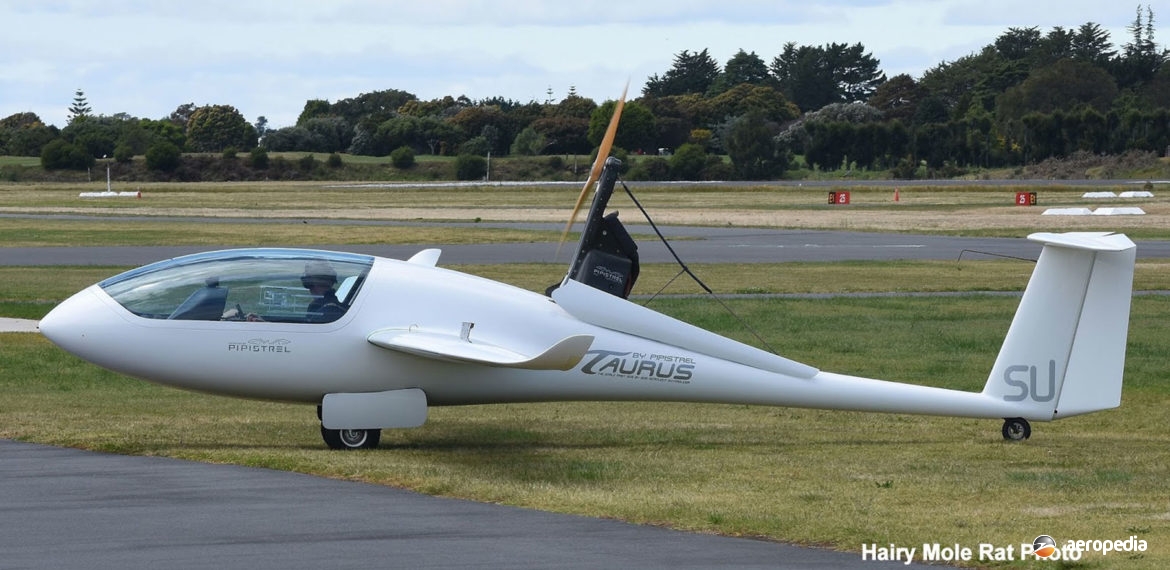Photograph:
Pipistrel Taurus 503 ZK-GSU (c/n 035T503) in 2015 (NZCIVAIR)
Country of origin:
Slovenia
Description:
Two-seat self-launched glider
Power Plant:
One 53 kw (71 hp) Rotax 503 UL 2V two-cylinder, two-stroke, fan-cooled engine with electronic dual ignition
Specifications:
- Wingspan: 14.97 m (49 ft 1 in)
- Length: 7.27 m (23 ft 10 in)
- Height: 1.41 m (4 ft 8 in)
- Wing area: 12.33 m² (132.7 sq ft)
- Max speed with flaps extended: 130 km/h (81 mph)
- Stalling speed with flaps: 63 km/h (39 mph)
- Never exceed speed: 225 km/h (140 mph)
- Max glide ratio: 41:1
- Rate of sink: 42.6 m/min (140 ft/min)
- Take-off run: 115 m (377 ft)
- Service ceiling: 6,797 m (22,300 ft)
- Endurance: 2.3 hrs
- Range: 324 km (201 miles)
- Empty weight: 285 kg (628 lb)
- Loaded weight: 450 kg (992 lb)
History:
The Taurus is a light sport aircraft produced in Slovenia and, like the other aircraft in the Company’s range, is basically a self-launched glider. It is powered by a Rotax 503 engine driving a two-blade propeller which, when not in use, is stored behind the cockpit in the fuselage. Seating is for two side-by-side and construction is all-composite. It uses the wings of the Sinus with a new fuselage. In 2007 the Company launched a variant known as the Taurus Electro, replacing the Rotax engine with a 30 kw (40 hp) Sinedon electric three-phase brushless motor. The piston engine variant became known as the Taurus 503. A variant known as the Pureglider is unpowered. In 2011 a new Electro G2 model was launched fitted with a 40 kw (54 hp) engine using lithium batteries which has a powered endurance of 17 minutes permitting self-launching to an altitude of 2,000 m (6,500 ft).
One variant was the Taurus G-4, a four-seat variant based on the Electro but with a 150 kw (201 hp) engine mounted on the central wing section. This machine had two fuselages with one person in each, this machine winning the Green Flight Challenge in September 2011, covering 649.35 km (403.5 passenger miles per gallon) and receiving the $1.35 million prize from NASA. The undercarriage was dual wheel.
The Electro model could be obtained with a glider trailer with solar panels built in so that the aircraft’s batteries could be charged. One of the first examples of the Taurus in the South Pacific became ZK-GSU. Further examples have been imported, including VH-NUF (c/n 139 T503) first registered on 17 June 2015 fitted with a Rotax 503 UL DCDI engine, and VH-ZHK (c/n 086-T 503) to its owner at Tocumwal, NSW in January 2016. A Taurus became VH-ZSH (c/n 169 T ET LSA) on 7 February 2019 to The Vake Tasmania Pty Ltd of Kent Town, SA.
In New Zealand the type is classed as a Class 2 Microlight. Two examples have been imported. The first was a Taurus 503 which became ZK-GSU (c/n 035T503) on 18 March 2009 to Ricco Legler of Russell. It later went to the Kaahu Trust of Russell, later going to the Tauranga Gliding Club on 5 November 2015. Mr Legler later replaced it with an Electro model, ZK-GEL² (c/n 147TAel), registered to the Kaaha Trust of Russell on 23 November 2015. It was based at Kaikohe but was destroyed when it crashed near Kaikohe on 16 November 2017.

